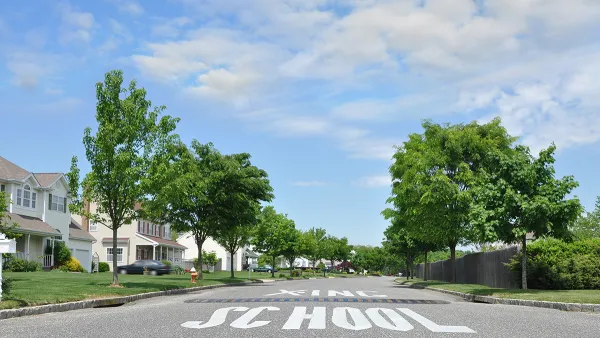Newly released population data provides entre for a discussion about the nature of cities.

Following on this week's big reveal of the updated U.S. Census population estimates for 2014, Jed Kolko digs into the data to reveal a trait common on among many of the country's fastest growing "cities": they're actually more like suburbs. In fact, according to Kolko's analysis, three of the ten largest cities in the country are actually more suburban than urban (viz., Phoenix, San Antonio, and San Diego).
Kolko notes that a lack of a clear distinction between suburban and urban lends ambiguity to the Census population data. To place the findings in a more useful context, Kolko uses a definition reached by a survey performed by Trulia.
"Our analysis showed that the single best predictor of whether someone said his or her area was urban, suburban or rural was ZIP code density. Residents of ZIP codes with more than 2,213 households per square mile typically described their area as urban. Residents of neighborhoods with 102 to 2,213 households per square mile typically called their area suburban. In ZIP codes with fewer than 102 households per square mile, residents typically said they lived in a rural area.2 The density cutoff we found between urban and suburban — 2,213 households per square mile — is roughly equal to the density of ZIP codes 22046 (Falls Church in Northern Virginia); 91367 (Woodland Hills in California’s San Fernando Valley); and 07666 (Teaneck, New Jersey)."
From this analysis comes a few interesting conclusions, such as a case for the uniquely urban qualities of New York and the surprisingly urban qualities of Los Angeles. Also, many of the fastest growing cities in the country are surprisingly suburban. According to Kolko, "[a]mong the 10 fastest-growing cities with more than 500,000 people, five — Austin, Fort Worth, Charlotte, San Antonio and Phoenix — are majority suburban, and a sixth, Las Vegas, is only 50 percent urban. Only one of the 10 fastest-growing, Seattle, is at least 90 percent urban."
FULL STORY: How Suburban Are Big American Cities?

National Parks Layoffs Will Cause Communities to Lose Billions
Thousands of essential park workers were laid off this week, just before the busy spring break season.

Retro-silient?: America’s First “Eco-burb,” The Woodlands Turns 50
A master-planned community north of Houston offers lessons on green infrastructure and resilient design, but falls short of its founder’s lofty affordability and walkability goals.

Delivering for America Plan Will Downgrade Mail Service in at Least 49.5 Percent of Zip Codes
Republican and Democrat lawmakers criticize the plan for its disproportionate negative impact on rural communities.

Test News Post 1
This is a summary

Test News Headline 46
Test for the image on the front page.

Balancing Bombs and Butterflies: How the National Guard Protects a Rare Species
The National Guard at Fort Indiantown Gap uses GIS technology and land management strategies to balance military training with conservation efforts, ensuring the survival of the rare eastern regal fritillary butterfly.
Urban Design for Planners 1: Software Tools
This six-course series explores essential urban design concepts using open source software and equips planners with the tools they need to participate fully in the urban design process.
Planning for Universal Design
Learn the tools for implementing Universal Design in planning regulations.
EMC Planning Group, Inc.
Planetizen
Planetizen
Mpact (formerly Rail~Volution)
Great Falls Development Authority, Inc.
HUDs Office of Policy Development and Research
NYU Wagner Graduate School of Public Service





























